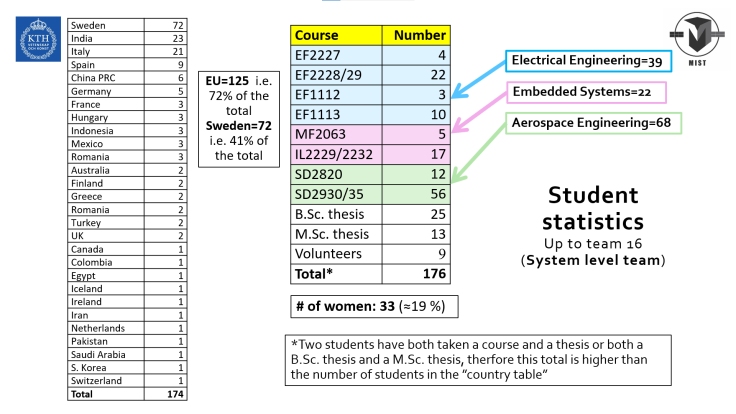Purpose, start and overall status
Many universities in the world have built small satellites called Cubesats. The KTH Space Center started its own Cubesat project,MIST, on January 28, 2015. The satellite is a 3U CubeSat, to be built primarily by students working in small teams. A new team will work on the project every semester. The project was defined in 2014, and the work started start in early 2015. The project is led by Sven Grahn, an experienced satellite project manager.
Eight technical and scientific experiments to be included in the KTH student satellite MIST (MIniature STudent satellite) have now been selected (see Experiment Descriptions). The experiments have been proposed from inside KTH and from a Swedish company.

All purchased satellite subsystems have been delivered. The ground station is ready. All technical/scientific experiments have been delivered except one that is expected to be completed soon. Final testing of the satellite is expected to be completed in 2023 and the launch can then be planned.
Technical information
A detailed technical description of the project can be found here. In brief:
- The satellite is a so-called three-unit Cubesat, i.e. it has the volume 3 liters, the outer dimensions 10 x 10 x 30 cm and weighs 3.3 kg.
- The satellite subsystems are purchased from the Dutch company ISISPACE except the onboard computer software which is developed by the students.
- The satellite transmission frequency will be 437.405 MHz and the reception frequency 145.860 MHz.
- The experiments on board are shown in the table below.
The MIST work is carried out in two adjacent rooms in the Alfvén laboratory at Teknikringen 31. The Ground Station antenna system was set up on the roof of Teknikringen 31 during the fall semester 2020.
Student work
The idea is that the students should perform analytical, design, verification and management tasks in a real space project and thus learn “project work in real life”:
- In order to provide sufficient depth in learning and to ensure continuity in knowledge transfer between students, students are recruited every semester and they normally stay two semesters in the project.
- Most students join the project at the beginning of the fall or spring semester during their fourth academic year.
- We have/had many B.Sc and M.Sc. thesis workers.
- The students normally work academic credits through project courses in “space technology” within the EECS and SCI schools and “embedded systems” within EECS.
- Occasional “volunteer” students also contribute.
- The table below shows statistics for those who have participated up to and through the fall 2022 semester.
Each student is part of a sub-team that can consist of up to 5 students. This sub-team is working on a certain aspect of the project, such as:
- thermal design and test,
- attitude control,
- mechanical design and test,
- on-board software,
- ground station and mission operations,
- functional testing and mission simulations
The day-to-day work
The members of a team work together on different aspects of their group assignment and have their own team meetings where they plan and evaluate the work. On their own initiative, they contact the project manager, supervisors or courses assistants when needed to determine the most appropriate way forward. Each sub-team also interacts with other sub-teams and holds meetings with them to sort out technical aspects of the interface between the work of the different groups. Each team reports orally at the project meetings (IRL and Zoom on Wednesdays) about the status, what should happen next and about any problems that need to be solved. Each student in a sub-team describes his or her part of the work.
Reporting
A larger three-hour review of the project situation is held in the middle of each semester (during the first day of the own-study period, before exams). A comprehensive debriefing meeting is held at the end of the semester (also during the first day of the own-studies period, before the exams). The students who are to start their work next semester are often at this end-of-semester meeting. The end-of-semester meetings are often held with the presence of a technical representative of the Swedish Space Agency.
The students in a team write numerous technical memos, reports, drawings, code, yes what is needed. At the end of their work on the project, they write a report. If it is common to the team,it must be clear who has done and writtenwhat. An important part of this report is what the next group of students needs to address and suggestions how they can organize the job – a handover of the baton! Their report(s) is reviewed by me, supervisors and course assistants and handed over to the formal course coordinator for approval and assignment of course credits – once the report is approved.



Leave a comment